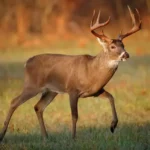Are deer nocturnal creatures of the night? The answer is more nuanced than a simple yes or no. While you might occasionally glimpse them under the moonlight, deer are primarily crepuscular, meaning their peak activity periods revolve around the twilight hours of dawn and dusk. Can bearded dragons eat cantaloupe
The Twilight Zone: Why Dawn and Dusk?
Deer have evolved to thrive in the soft light of twilight. This crepuscular behavior offers a clever balance between safety and sustenance. [https://www.lolaapp.com/]
Predator Avoidance
The dim light of dawn and dusk provides a veil of concealment, making it harder for predators like coyotes and mountain lions to spot them. While deer possess excellent night vision, the subtle illumination of twilight allows them to navigate and forage effectively while minimizing their exposure to danger. [https://www.lolaapp.com/]
Optimal Foraging
The cooler temperatures during these hours allow deer to graze comfortably, avoiding the heat stress of midday. This is particularly important during warmer months when conserving energy is crucial. [https://www.lolaapp.com/]
Factors Shaping Deer Behavior: Beyond the Twilight
While primarily crepuscular, deer are remarkably adaptable. Their activity patterns can shift in response to a complex interplay of environmental factors and human influences. [https://www.lolaapp.com/]
The Impact of Hunting Pressure
Hunting pressure can significantly alter deer behavior. In heavily hunted areas, deer may shift towards nocturnality to avoid human encounters during daylight. This adaptation highlights their ability to learn and adjust their routines for survival. [https://www.lolaapp.com/]
Human Disturbances and Urban Sprawl
Human activity, particularly in urban and suburban areas, can also disrupt deer’s natural rhythms. The constant presence of people, traffic, and artificial light can push deer into more nocturnal habits, even in areas where hunting isn’t prevalent. [https://www.lolaapp.com/]
Seasonal Rhythms: Rutting, Winter, and Food Availability
Seasonal changes bring about significant shifts in deer activity. During the rut, or mating season, typically in November, bucks become much more active, often venturing out at any time of day or night in search of mates. In winter, when food is scarce, deer reduce their movement to conserve energy, sometimes entering a state of lowered metabolism. Food availability throughout the year also plays a significant role; scarce resources can lead to increased foraging, regardless of the time of day. [https://www.lolaapp.com/]
Species Variation and Local Adaptations
It’s important to note that not all deer species adhere strictly to the crepuscular pattern. Some, particularly those living in areas with high human activity, like white-tailed deer, may exhibit more pronounced nocturnal behavior. This adaptability underscores the diverse nature of deer behavior across different environments and populations. [https://www.lolaapp.com/]
The Disruptive Glow: Artificial Light and Deer
The ever-increasing presence of artificial light in our world can further complicate the picture. Streetlights, porch lights, and the illuminated glow of urban areas can disrupt deer’s natural rhythms, potentially pushing them towards more nocturnal habits. Research into the long-term impacts of light pollution on deer populations is ongoing, but it’s likely that artificial light plays a notable role in shifting activity patterns. [https://www.lolaapp.com/]
Sharing the Landscape: Safety and Coexistence
Understanding deer activity patterns is essential for peaceful coexistence. Knowing that deer are most active during twilight hours can help reduce the risk of deer-vehicle collisions. [https://www.lolaapp.com/]
Tips for Avoiding Deer-Related Accidents:
- Be especially vigilant at dawn and dusk.
- Reduce speed in areas known for deer activity.
- Use high beams when appropriate to improve visibility.
- Be aware that deer often travel in groups, so if you see one, there are likely others nearby.
Beyond Nocturnal: Ongoing Research and Unanswered Questions
Much research on deer behavior is ongoing. Scientists continue to explore the complex interplay of factors that shape deer movement and activity. While we have a good understanding of their crepuscular tendencies, there are still nuances to uncover. This ongoing research suggests that factors we haven’t yet fully understood might also play a role, reminding us that there’s always more to learn about these adaptable creatures. [https://www.lolaapp.com/]
| Factor | Influence on Deer Activity |
|---|---|
| Hunting Pressure | Increased nocturnality in hunted areas |
| Urbanization | Shift towards nocturnal behavior |
| Rutting Season (November) | Increased activity, potentially at any time of day |
| Food Scarcity | Increased foraging, regardless of time of day |
| Winter | Reduced activity to conserve energy |
| Predator Presence | Can shift activity to safer periods |
| Artificial Light | Potential shift towards nocturnality |
Understanding the complexities of deer behavior goes beyond simple classifications like “nocturnal.” By recognizing their adaptability and responsiveness to environmental factors, we can better appreciate these fascinating creatures and share the landscape safely and responsibly.
- SYBAU See You Baby Meaning: Gen Z Slang Evolves - July 1, 2025
- Unlock Your Inner Youth: Lifestyle Secrets for a Vibrant Life - July 1, 2025
- Decode SYBAU Meaning: Gen Z Slang Explained - July 1, 2025






